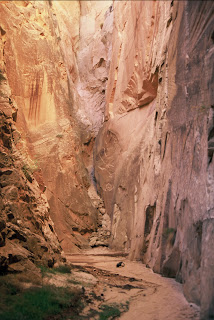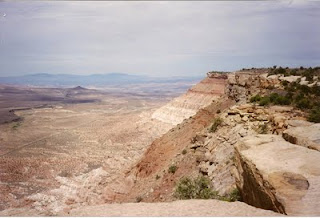In fact several of the photos in the sidebars are from this area. The Wave has unique color and texture and consistency in the rock that makes it very photogenic. Along with the type of erosion that has left smooth curved shapes. This attracts photographers from all over the world.
The Wave is in the part of the Coyote Buttes that is designated as the North section, but there is also some interesting stuff to see in the south section as well. The South Section is a bit tougher to get to because the roads are sandy and require four wheel drive. In fact even with four wheel drive there were parts that had deep sand that made me wonder if I was going to get stuck. I highly advise you to go in a group with two four wheel drive vehicels if you can. I also recommend you have a tire pump so you can deflate your tires some in the sand and then re-inflate when you get back to the road. A shovel and winch are always nice as well. If you are not familure with off road travel and reading maps, this one is not for you.
When I went to this area it was many years ago and I backpacked in and stayed over night with my wife. Sad to say they no longer alow overnight camping in this area. Anyway we drove our car as far as a place called Paw Hole and then walked north in towards what is known as the Cottonwood Teepee area. We did not follow a trail or anything, I just used a topo map and headed toward the Cottonwood Teepee area
We decided to park at Paw hole because the road beyond that was pure sand, and even up to there there were areas where we crossed some very deep sand and I felt I had taken enough risks already. Many people continue on past Paw Hole and drive to a parking and access spot they call Cottonwood Cove. This would make the Cottonwood Teepees just a short walk to get to.
We first set out from Paw Hole here we were treated with seeing some beautiful rock formations with precice linear designs and textures in all sorts of strange shapes and sizes.
Most of these were tan, gold or redish brown in color, and some had unusual linear textures of darker colored rock running through them. This is just a short walk north of the Paw Hole Parking Area.
There were some very unusual Teepees with some real crazy texture way up the ridge north of here that we saw on our way back.
We traveled north from Paw Hole on a flat sandy area just east of the ridge on the way out and we traveled along the top of the ridge or as close as we could on the way back. Walking north we crossed a large area of more sand that with full packs was quite draining, after several miles we came to another area of exposed rock and more unusual formations.
This area was near what on the map was called Cottonwood Springs, and I latter found out it was called the Cottonwood Teepee area. Walking around in this area was amazing.
This area has some crazy behive and teepee shaped rocks in quite an asortment of colors, sizes, and shapes, along with some balanced rocks and some just plain bizare shaped rocks, that will spark your imagination.
Everywhere you look you see something unusual in the geology here. Strange twisted shapes in a variety of colors and patterns.
And along with that there is a peacefulness that comes with this remote and secluded area. This are for me was more interesting more deversified and just a larger area than the Paw Hole area, but of course it's a bit more difficult to get to. Just a longer drive in some deep sand.
As you can see there is some strange shapes and unusual color in the rocks at this place, we had it all to ourselves when I was there.
Being able to stay overnight out in this remote destination was quite a treat. At night there was no visible human made light sources and with the dry air the star viewing was amazing.
Here is a hiking map that might be of use if you are going to Go out there and explore. remember there really are no trails, so you just have to use a map and keep track of where you have gone and how to get back.
The Lone Tree is an undeveloped access point that provides entry to Coyote Buttes South. There is limited parking available. It is not signed. Please park in existing disturbed areas only.From Page, AZ, drive west on Highway 89 for 34 miles (55 kilometers). Drive past the BLM Contact Station and the road to the White House trailhead. Turn left onto House Rock Valley Road. This road is compacted dirt. Drive 16.0 miles (25.75 kilometers) down this road. Turn left (east) on a narrow dirt track and drive 0.25 miles (0.4 kilometers) and park near a lone tree next to a small reservoir.
From Kanab, UT, drive east on Highway 89 for 38 miles (61 kilometers). Turn right onto House Rock Valley Road. This road is compacted dirt. Drive 16.0 miles (25.75 kilometers) down this road. Turn left (east) on a narrow dirt track and drive 0.25 miles (0.4 kilometers) and park near a lone tree next to a small reservoir.
For permits and more information here is the link to the BLM site that has all you need including how to obtain permits.
http://www.blm.gov/az/st/en/arolrsmain/paria/coyote_buttes.html
Here is the Link to the post on the Coyote Buttes North Section and The Wave. http://azjonesoutdoor.blogspot.com/2010/07/coyote-buttes-north-section.html





















































